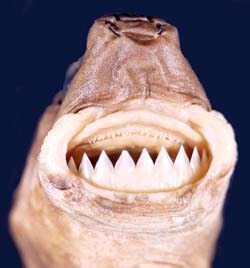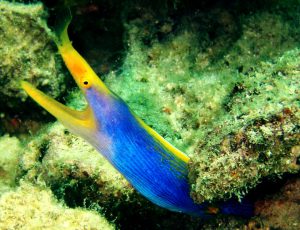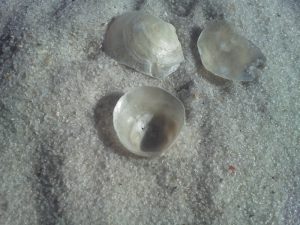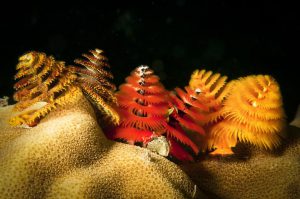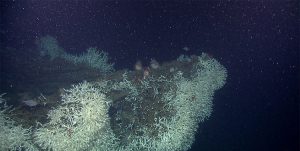The holiday season is a special time for most of us! There are many creatures that live under the sea that represent many of our holiday traditions.
Photo Credit: Fl. Museum Of Natural History, George Burgess
Small cookie cutter sharks are found in very deep water during the day, at night they migrate up the water column to feed. Cookie cutter sharks attract their prey with lighted photophores. Photophores are lighted organs located on the lower part of the shark. Small fish are attached to the glow, larger fish searching for prey get close enough to the shark and the shark bites the prey. The cookie cutter shark has specialized sucking lips that attach to the victim. The shark then spins its body around and leaves a cookie cutter shaped hole in the fish.
Photo credit: Wikimedia Commons
Ribbon Eels are found in the Indio Pacific. They have long slender bodies and move like ribbons in and through the crevices reefs. They eat live fish. To view a YouTube video of ribbon fish feeding, click here.
Photo credit: Chris Verlinde
Jingle shells get their name as a result of their shells that when shaken together make a jingle like sound. Jingle shells can be found along the beaches of NW Florida. The shiny iridescent shell is strong and very attractive. Many shell collectors use the shells to make jewelry and wind chimes.
Jingle shells are bivalves and live attached to hard surfaces, just like oysters.
Jingle shells are filter feeders, meaning water is filtered through their gills for plankton.
Photo credit: Wikimedia commons
Christmas tree worms are Christmas tree shaped worms that form burrows corals. The tentacles, which form the tree-like structures are used for feeding on plankton and to breathe. These plumed creatures are a type of polychaete worm.
Christmas tree worms come in many colors and can be found all over the world. They feed by using their feathery appendages, called radioles to capture phytoplankton that floats by the “feathers.”
Christmas tree worms are easily disturbed and will quickly vanish into their burrows as shadows or larger marine life pass by. They return quickly and continue with their sedimentary lifestyles in the coral.
“Marine snow” falls gently on to a coral-covered shipwreck explored in the Gulf of Mexico in 2012 by the NOAA Ship Okeanos Explorer. Photo Credit NOAA
Marine snow gets its name as a result of the fluffy materials that resemble snow falling from the sky. Marine snow is decaying material from plants and animals that have died in the oceans. Marine snow may also include sand, fecal matter and inorganic dust.
Just like snowflakes, marine snow grows as it floats to the ocean depths. Marine snow is consumed by scavengers that live along the deep-sea floor bottom. Check out the video below showing the beauty of marine snow.
There are many more festive creatures that live in the sea. Have a wonderful Holiday Season!
- Explore Escribano Point Wildlife Management Area - November 19, 2021
- Team True Blue Provides Shark Data to increase NOAA Research on the Navarre Beach Fishing Pier - March 5, 2021
- Oyster Reef Mapping in the Pensacola Bay System, how is oyster reef mapping done? - January 22, 2021

